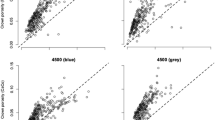Abstract
Canopy light interception (LI) is an important variable related to evapotranspiration, photosynthesis, primary productivity and yield in natural and managed vegetation, and the development of simple, reliable methods for its estimation is critical for research and practical purposes. This paper proposes a novel digital photographic technique for estimating canopy light interception based on the shadow projected by trees on the ground surface. A total of 607 pictures taken from 20 different walnut and almond orchards across California, USA, and with canopy covers ranging from 5 to 98 % were processed to derive canopy shadow fraction and compared with LI recorded at the same time and location from a mobile platform of ceptometers, the mobile light bar (MLB), which systematically collected data as it is moved under the trees. Light interception values obtained with the photographic technique were highly correlated and very similar to those of the MLB (R2 = 0.95).The contribution of MLB sampling error and other factors that lead to differences in light interception values between the two methods was analyzed and discussed. The image acquisition and processing in this new technique does not require special or expensive equipment, software or training and can be easily adopted by researchers and farmers, and the generated information can be combined with satellite imagery to extend to the orchard and regional scales. The advantages and limitations of the proposed technique are discussed along with suggestions for further improvements and automation which could lead to more accurate results and wider application for research and crop management purposes.








Similar content being viewed by others
References
Adams, J. E., & Arkin, G. F. (1977). A light interception method for measuring row crop ground cover. Soil Science Society of America Journal, 41(4), 789–792.
Atwell, B. J., Kriedemann, P. E., & Turnbull, C. G. N. (Eds.). (1999). Plants in action: Adaptation in nature, performance in cultivation. Australia: Macmillan Education.
Baret, F., & Guyot, G. (1991). Potentials and limits of vegetation indices for LAI and APAR assessment. Remote Sensing of the Environment, 35(2), 161–173.
Bréda, N. J. J. (2003). Ground-based measurements of leaf area index: A review of methods, instruments and current controversies. Journal of Experimental Botany, 54(392), 2403–2417.
Campillo, C., Fortes, R., & del Henar-Prieto, M. (2012). Solar radiation effect on crop production. In: Elisha B. Babatunde, (Ed.), Solar Radiation. InTech. http://www.intechopen.com/books/solar-radiation/solar-radiation-effect-on-crop-production. Accessed January 7 2014.
Cescatti, A., & Niinemets, U. (2004). Leaf to landscape. In W. K. Smith, T. C. Vogelmann, & C. Critchley (Eds.), Photosynthetic adaptation: Chloroplast to landscape. New York: Springer.
GIMP Documentation Team (2013). GIMP user manual. http://docs.gimp.org/2.8/en/. Accessed January 8 2014.
Gonias, E. D., Oosterhuis, D. M., Bibi, A. C., & Purcell, L. C. (2012). Estimating light interception by cotton using a digital imaging technique. American Journal of Experimental Agriculture, 2(1), 1–8.
Jonckheere, I., Fleck, S., Nackaerts, K., Muysa, B., Coppin, P., Weiss, M., & Baret, F. (2004). Review of methods for in situ leaf area index determination. Part I. Theories, sensors and hemispherical photography. Agricultural and Forest Meteorology, 121(1), 19–35.
Kobayashi, H., Ryu, Y., Baldocchi, D. D., Welles, J. M., & Norman, J. M. (2013). On the correct estimation of gap fraction: How to remove scattered radiation in gap fraction measurements? Agricultural and Forest Meteorology, 174–175, 170–183.
Lampinen, B. D., Udompetaikul, V., Browne, G. T., Metcalf, S. G., Stewart, W. L., Contador, L., & Upadhyaya, S. K. (2012). A mobile platform for measuring canopy photosynthetically active radiation interception in orchard systems. HortTechnology, 22(2), 237–244.
Law, B. E. (1995). Estimation of leaf area index and light intercepted by shrubs from digital videography. Remote Sensing of the Environment, 51(2), 276–280.
Long, B. (2010). Complete digital photography (5th ed.). Boston, Massachussets, USA: Cengage Learning.
Næsset, E. (2001). Effects of differential single-and dual-frequency GPS and GLONASS observations on point accuracy under forest canopies. Photogrammetric Engineering and Remote Sensing, 67(9), 1021–1026.
Rasband, W. S. (1997–2012). ImageJ, U. S. National Institutes of Health. Bethesda, Maryland, USA. http://imagej.nih.gov/ij/. Last accessed December 15 2013.
Smith, W. K., Knapp, A. K., & Reiners, W. A. (1989). Penumbral effects on sunlight penetration in plant communities. Ecology, 70(6), 1603–1609.
Stewart, A. M., Edmisten, K. L., Wells, R., & Collins, G. D. (2007). Measuring canopy coverage with digital imaging. Communications in Soil Science and Plant Analysis, 38(7–8), 895–902.
Turner, D. P., Ollinger, S. V., & Kimball, J. S. (2004). Integrating remote sensing and ecosystem process models for landscape- to regional-scale analysis of the carbon cycle. BioScience, 54(6), 573–584.
Woolley, J. T. (1971). Reflectance and transmittance of light by leaves. Plant Physiology, 47(5), 656–662.
Yoshimura, T., & Hasegawa, H. (2003). Comparing the precision and accuracy of GPS positioning in forested areas. Journal of Forest Research, 8(3), 147–152.
Zarate-Valdez, J. L., Whiting, M. L., Lampinen, B. D., Metcalf, S., Ustin, S. L., & Brown, P. H. (2012). Prediction of leaf area index in almonds by vegetation indexes. Computers and Electronics in Agriculture, 85, 24–32.
Acknowledgments
The authors want to thank the California Walnut Board and the Almond Board of California for their financial support for this study.
Author information
Authors and Affiliations
Corresponding author
Rights and permissions
About this article
Cite this article
Zarate-Valdez, J.L., Metcalf, S., Stewart, W. et al. Estimating light interception in tree crops with digital images of canopy shadow. Precision Agric 16, 425–440 (2015). https://doi.org/10.1007/s11119-015-9387-8
Published:
Issue Date:
DOI: https://doi.org/10.1007/s11119-015-9387-8




